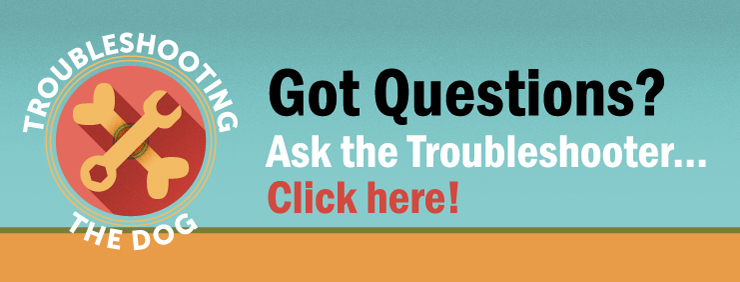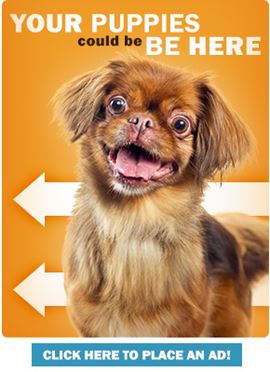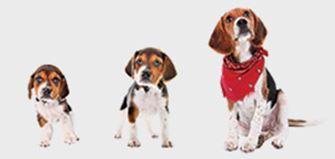
Troubleshooting the Dog: Jumping
Dear Troubleshooter,
I have a goldendoodle that will be three next month. He gets very excited when people are around and wants to jump on everyone he sees. How do I stop him from jumping up on people?
Thanks!
Jumping J
READ THE RESPONSE BELOW
Dear Jumping J,
Fortunately for you and your goldendoodle, jumping is one of the easiest behaviors to correct!
Jumping is a natural behavior that many dogs will exhibit toward humans when permitted. They do it for many reasons. Some misled people will attribute it to dominance, claiming it is the dog’s way of “getting on your level,” but this is actually the opposite of what is going on here.
When dogs are young, like their wild cousin the grey wolf, the puppies and cubs will jump up to lick, nip, and paw at the mouths of their mothers and pack mates to stimulate regurgitation. As they grow, they use this behavior to show respect to other members. So, when a dog is jumping up, he’s actually showing you that he wants to interact and also being friendly.
Unfortunately for your dog, most people do not appreciate this friendly gesture, and it can actually cause injury if the dog accidentally scratches with his nails or knocks an unsteady person or small child over.
Jumping behavior usually starts early during puppyhood, when the puppy will instinctively jump up on a new owner for attention. As a puppy, it is hardly even noticed, or even encouraged by the owner petting, playing with, or picking the puppy up. Over time, as the dog grows, so does the problem with jumping up.
However, most owners are surprised to see that dogs tend to keep doing it, despite corrections and punishments. This is because, although he’s getting corrected or punished, he’s still getting what he wanted—attention. This is similar to a child that acts out. At some point, the dog decides that even negative attention, such as corrections and punishment, will get him some interaction with people, and the negative attention then becomes a reward in itself.
Operant conditioning, one of the theories of learning, dictates that rewarded behaviors will most likely continue and increase in frequency, intensity, and duration. So, at three years old, the dog has likely received a LOT of rewards for the jumping behavior, or else he wouldn’t still be doing it.
The best way to correct this problem is to replace the less desirable affectionate behavior (jumping up) with a more appropriate behavior that gains him access to what he really wants—attention and interaction! We do this by teaching a simple “sit” command.
Once your dog understands the sit command, he will need to sit for everything he wants in life—forever. It sounds drastic, but we do this for a few reasons:
1.) It teaches him manners and makes life much easier for both owner and dog.
2.) It teaches impulse control, which is important. A lack of impulse control is a major factor in jumping up as well as misbehaving around other people and dogs (i.e., barking at the other dogs).
3.) It fixes most undesirable behaviors. A dog cannot lunge, jump, bolt, or pull on a leash when his butt is planted firmly on the ground.
4.) Lastly, it’s self-rewarding. It allows the dog to be gentler and more approachable, which leads to exactly what the dog wants: interaction with people. People enjoy interacting with a dog that sits politely rather than jumping all over them and lunging at other dogs and people.
Let’s Get Started!
Once your dog understands the sit command, have him sit for everything in his life—food, toys, play, affection, interacting with other dogs and people, and going outdoors.
Sit for a friendly greeting
Have your dog sit, and remain sitting, anytime anyone (including yourself) wants to pet, groom, or interact with him in any way. The minute his butt or front paws leave the ground, discontinue interacting and turn away. Ask him to sit again, and as soon as he resumes the sit, you can continue interacting with him.
Practice this with a friend
Have your dog on-leash in a sit. As your friend approaches, have him remain sitting. If your dog stands to lunge or jump, have your friend stop and move the opposite way. Your dog will learn that as long as he’s sitting, the people will come to him and interact with him, but the moment he breaks the sit, people will move away from him, thus removing the reward. Whenever someone comes to your house or asks to pet your dog in the street, have your dog sit first. Most will be delighted to see your dog’s trick. You can even explain that they are helping with training and have them reward him with a treat as well!
Sit for food
Have your dog sit prior to setting down the food bowl. Slowly put the bowl down to the ground. If your dog breaks the sit prior to you telling him it’s okay to eat (when the bowl is down on the ground and he’s seated politely), pick the bowl up and have him sit again. Dogs catch on to this very quickly. They realize that as long as their butt stays put on the ground, the food bowl will be there as well.
Sit for doors and gates
Allowing your dog to bolt out of a door or a gate does him no favors; it’s dangerous and only diminishes impulse control. From this point on, have him sit politely before, during, and after opening gates. He should only be allowed to go through once you give him the all-clear. Have him on a leash to ensure that you can maintain control at all times.
Sit for walks
Often, dogs with impulse control issues are also not the most enjoyable to take for a walk. They tend to pull and forge ahead, making the walk more of a game of tug-o-war. Here again the rules of operant conditioning ring true: they have learned that if they pull on the leash, they get what they want, which is to go forward. So, sitting eliminates the reward of moving forward. If they are sitting, they can’t pull. Teach your dog that when he pulls, he does not get to go forward. When your dog starts to pull ahead, have him sit and do not let him move until he’s sitting politely.
When you first begin, remember, you are undoing three years of pulling rewards. Your first several walks may be a total span of 15 feet. Eventually, dogs quickly understand that if they want to go forward, pulling on the leash is out. I prefer my dogs to walk at my side, so mine learn that when they’re walking politely beside me, we go forward.
Try these out over the next few weeks and let us know how you and your pup do with it!
The Troubleshooter











 Affiliate Clubs
Affiliate Clubs




